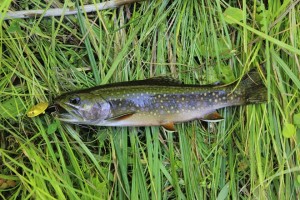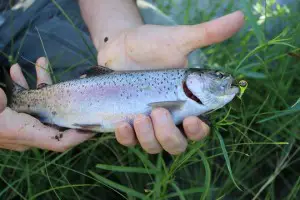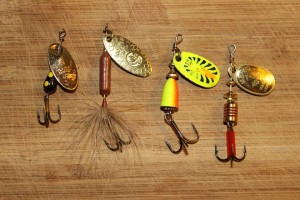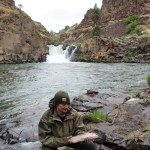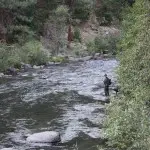Search
Latest Articles
All About Trout Spinners
by Terry Otto for Anglers Club Magazine, December 27, 2015
These four trout spinners need to be in your vest. #1: Panther Martin Original, #2: Worden’s Rooster Tail, #3: Blue Fox Vibrax, #4: Mepps Aglia
The smiles on their faces said it all: catching trout with a spinner is fun! And, it’s as easy as casting them out, and reeling them in. The spinner does the work for you.

Always a major part of my fishing arsenal, spinners have proven effective on trout from the Adirondacks to the Olympic Mountains. I have used spinners for every kind of trout imaginable; cutthroats, browns, rainbows, golden trout, brook trout, bull trout, and more. The simple truth is that, while people seem reluctant to fish them, trout love spinners.
In this article we’ll cover the best trout spinners out there, and discuss how to use them effectively.
The best trout spinners:
If you find me on trout water, these essential and proven spinners will be in my box.
#1: Panther Martin Original

This eastern brook trout fell for a Panther Martin trout spinner. Photo Credit Terry Otto
Without a doubt, this is one of the best trout spinners ever made. They are especially effective in small creeks, but will land fish in larger rivers, too. While snorkeling streams I have watched trout hit these baits, and it is amazing how aggressive the attack is. Pair the 1/16th oz size with 4 pound test, and try it in riffles and pools.
The Original, with a copper blade and black body, is hard to beat in clear water.
#2: Worden’s Rooster Tail
While the Rooster Tail spinners are effective in larger streams, they really shine in lakes. They are a fairly heavy lure and cast well with light line. This allows you to cover more water, and a few split shot about 18 inches up the line will help them cast even farther.
Retrieve them near the surface in the morning and evening, and roll them slowly along the bottom in the mid-day. They can also be trolled, with flashers or without. When the trout are slow and sluggish, try the new Vibric Rooster Tail. These baits have a weighted keel and a shaft-through blade design that allows the blade to spin at extremely slow speeds.
Brown body Rooster Tails with copper blades are killer in clear lakes. Try tipping one of the hooks with a bit of black Berkley Trout Worm for some added attractant.
#3 Blue Fox Vibrax

Jeff Otto, the author’s son, with a Deschutes River rainbow caught on a Blue Fox Vibrax
The Blue Fox Vibrax is often thought of as a steelhead bait, but the smaller sizes make for excellent trout spinners. The color selection differs from other spinners, and that opens up a lot of options for the trout angler.

A rainbow trout that hit a chartreuse Blue Fox Vibrax spinner.Photo credit Terry Otto
These spinners are effective in both lakes and streams. Like the Rooster Tail, they can be trolled or casted. They come in several chartreuse color variations, which are especially effective on trout in glacial or dirty water.
#4-Mepps Aglia
The simple design and pattern of the Mepp’s Aglia Spinner has been proven for decades, and they were one of the first spinners I used for trout. Size zero through two will take trout anywhere, and the original, un-dressed version is still one of my favorites.
A quick word on colors:
In clear water the copper blades and dark colors tend to fish the best. If the water is dirty or murky, try silver and chartreuse.
The Rio Grande River is one of the biggest western rivers I had ever fished for trout, and I was vexed. What to use? I went with an old favorite and tied on a brown Rooster Tail trout spinner, and in just a few casts I hooked up. I battled a 12 inch brown trout to the net.
He was the first of many trout I landed that afternoon, all taken on that same spinner.
Spinners work on two of the trout’s senses, sight and sound. In addition to the visible flashing of the blade, trout are drawn to the pulsating vibrations of the lure. Hungry trout sense a catchable morsel, and they’ll attack spinners savagely.
Trout spinners: easy to master
Trout spinners are easy to use. Once cast, it’s a simple matter of maintaining enough speed on the retrieve to keep the blade turning. After just a few casts, most fishermen can become familiar with the “feel” of the spinning blade, and can sense when it is not working. Usually, the slowest retrieve possible will work best.
Also, trout spinners are a great hunting lure, which means they can be used to cover a lot of water quickly, and locate schools of feeding trout. If fishing from a boat or bank, keep moving until you find the fish. Then, concentrate your efforts in that spot.
Drop-offs, the deep edges of channels, the mouths of tributary streams, and wind-blown banks are places to look for trout in lakes. Also, work the edges of grassy flats. In most situations you will find the fish shallow in the early morning and late evening, and deeper in the mid-day, often holding right on the bottom.
Trout spinners in moving water
Spinners are very effective in streams, either large or small. Smaller spinners are the best bet in creeks, but in larger rivers you can toss the bigger sizes with success.

Jeff Otto with a 20 -inch rainbow trout that fell for a Blue Fox Vibrax spinner
Cast the trout spinner upstream and begin retrieving until you feel the blade turning. As your spinner moves downstream it’s necessary to retrieve fast enough to keep the lure off the bottom. You can slow it down as the line straightens out and the current takes hold of the bait. At the bottom of the cast as the lure turns into the current, you can swing the bait through without reeling at all. The current will keep the blade turning.

Spinners are very effective in streams. Here the author’s son Jeff tosses a spinner to trout on the White River
Look for trout in deep pools, although they will also hold in runs, glides, and riffles. For the best results, work as much water as you can, and keep moving along the stream. Target the seams between fast and slow water. Trout will often hold along the edges of the current in these spots and snatch food as it drifts by. In larger rivers, look for trout in the eddies and back currents.
No matter the species, as trout grow they will switch from a diet of insects to feeding on small fish. Since the trout spinner mimics a baitfish, larger, trophy-size trout will often strike them with reckless abandon.
So, if you are tired of watching a bobber or tight-lining for trout with bait, switch it up and throw a spinner. You may be glad you did. Leave a comment with your trout spinners story.
Photos by Terry Otto
Reprinted with permission of Anglers Club Magazine.
